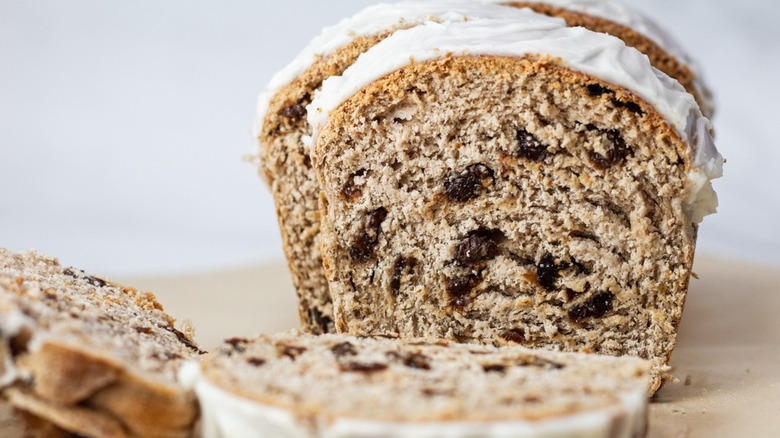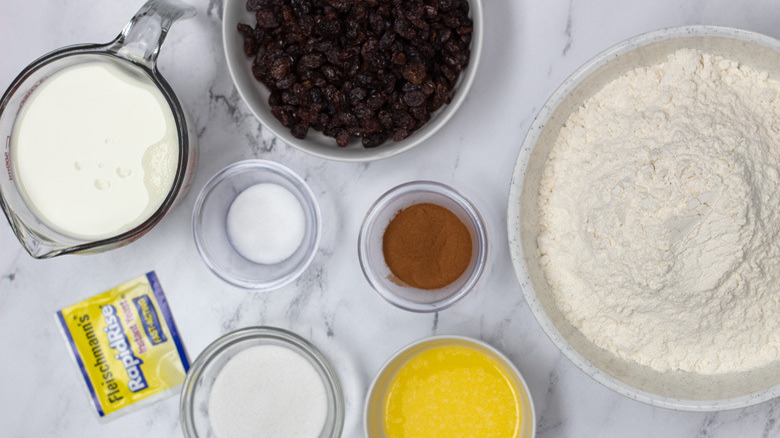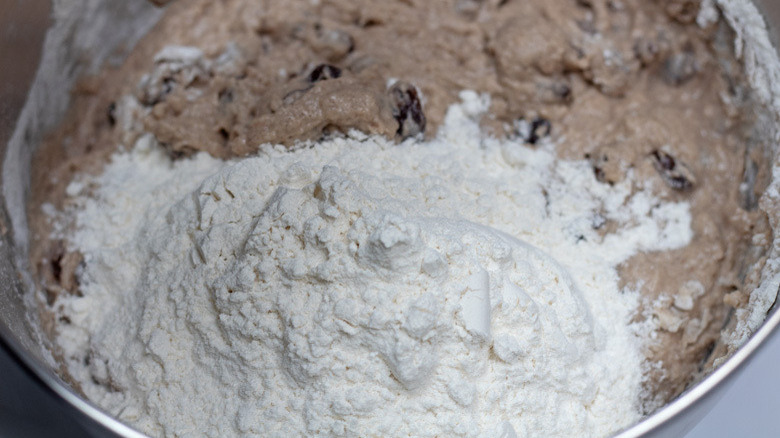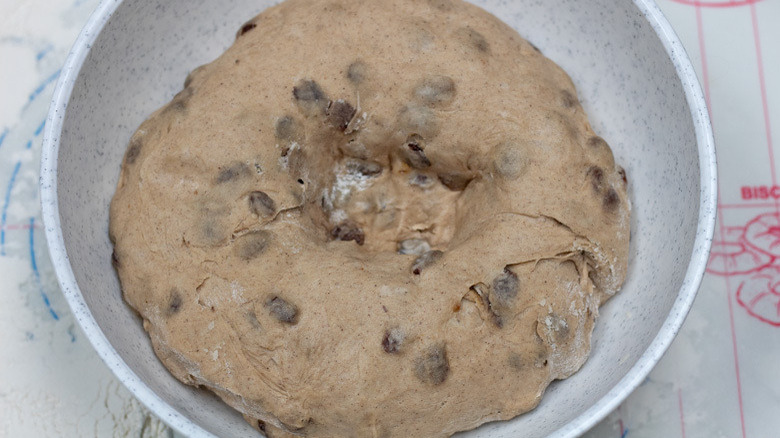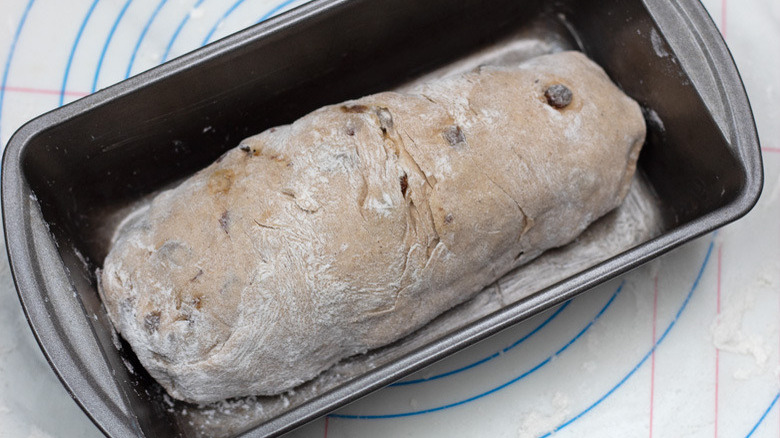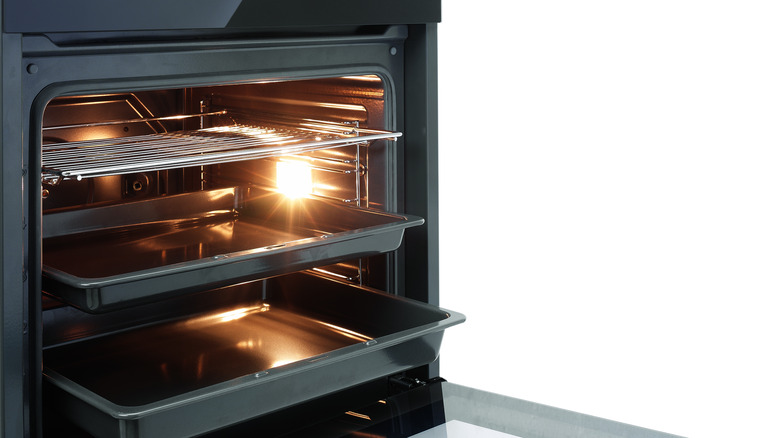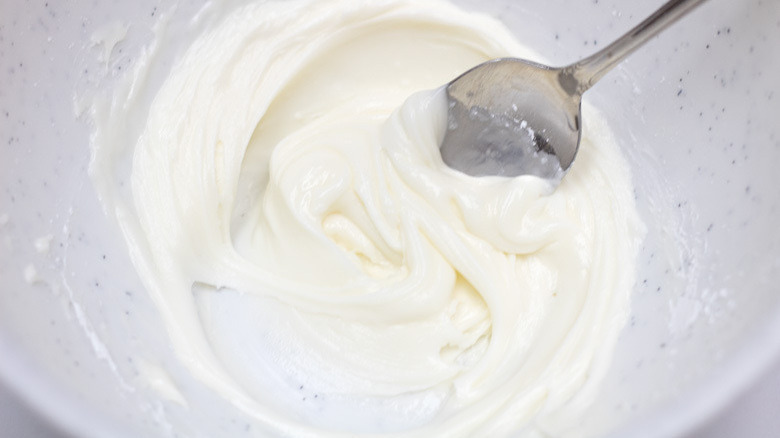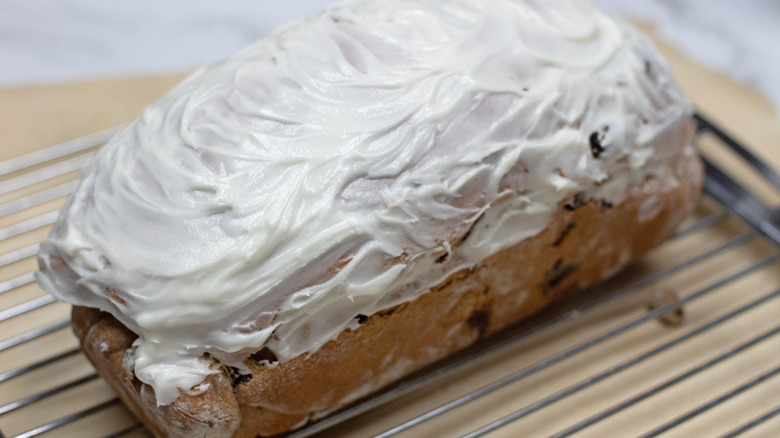Iced Raisin Bread Recipe
Cinnamon and raisins are one of those natural food pairings. They go together like, well, cinnamon and apples, or cinnamon and peaches, or cinnamon and pears ... Ok, we get the idea, cinnamon plays nicely with all manner of fruits, dried as well as fresh.
Recipe developer Angela Latimer, who blogs at Bake It With Love, is a big fan of the cinnamon-raisin flavor combo, and as her blog name implies, she's also pretty fond of baking. Naturally, she felt inspired to come up with this iced raisin bread recipe for us, something she tells us "is my FAVORITE cinnamon raisin bread hands down" because it "tastes like a cinnamon raisin bagel." While this recipe is actually on the time-consuming side as it's a yeast bread and not a quick one, it makes for a nice lazy fall weekend project. As Latimer says, "This bread is well worth the extra wait."
Assemble the ingredients for the raisin bread and icing
To make this bread, you'll need a fair amount of all-purpose flour. Latimer, explaining why she doesn't call for bread flour here, says that "I stick with AP flour in most recipes as more people commonly have it." You'll also need instant yeast, the kind that does not need to be activated on its own, as well as granulated sugar, salt, ground cinnamon, milk, butter, and raisins. If you'd like to experiment with something other than raisins, Latimer says, "Any kind of fruit can be added [but] preferably a dried fruit variety so it doesn't change the amount of flour needed [too] drastically."
To make the icing for this bread, you'll need three more ingredients: confectioners' (a.k.a. powdered) sugar, heavy (a.k.a. whipping) cream, and vanilla extract.
Begin by making the bread dough
Measure two cups of flour into a large bowl (which can be the bowl of a stand mixer) then add the yeast, granulated sugar, salt, and cinnamon. Latimer says you might want to try to add the sugar and yeast on one side and the salt and cinnamon on the other, explaining, "They can both inhibit the yeast activation." Mix the dry ingredients together. Now heat the milk until it reaches 105 to 100 F, then add it to the flour mixture along with the melted butter. Mix until your batter is smooth, then add the raisins along with the rest of the flour. Mix until you have a soft dough. Now comes the hard part — yep, it's time to knead.
If you are using a stand mixer, knead the dough for five to six minutes, until, as Latimer says "the dough slaps against the sides of the bowl." If you're kneading by hand, it will take six to eight minutes. You may not hear any slapping, but when the dough is done, it should be smooth and elastic.
Let the bread dough rise
Once the dough has been kneaded sufficiently, lightly oil the inside of a large bowl and transfer the dough to the bowl. Cover it with a clean towel and let it rise for an hour and a half, at which point it should have nearly doubled in size.
Because of the cinnamon, an ingredient Latimer says has the effect of slowing the dough's fermentation, it's recommended that you place the bowl of dough into the oven with a pan full of warm water beneath it. Should you happen to have a kitchen equipped with a proofing box (pretty high-level bread baking equipment), set it for 90 F. You may also be able to achieve this same effect if you're baking this bread in the summertime by simply switching off your air conditioning. As Latimer says, "It's best to create a warm proofing environment to speed [the rising] along, or just allow extra time for rising."
Shape the bread loaves and let them rise again
Once the dough has risen, punch it back down again. Yes, it seems cruel, but it's got to be done. Now divide the dough into two portions, and transfer one of the portions to a lightly floured work surface (a pastry mat, if you've got one). Roll the dough into a roughly rectangular shape that measures about 15 by seven inches. Starting at one of the short ends, roll the dough up into a loaf, and pinch the ends to seal.
Lightly oil or butter two nine-by-five-inch loaf pans. Transfer the first loaf to one of these pans, making sure the seam side is facing down. Repeat the whole loaf-forming process with the second half of the dough. Cover both loaves with a clean towel (it can be the same one you used earlier), and let them rise for another hour to an hour and a half. At this point, the dough should almost have reached the sides of the pan. Remember, as Latimer says, the loaves "will rise more once baked."
Bake the raisin bread
When the bread is almost done rising, preheat the oven to 350 F. Once it's hot enough and the bread has risen, bake the loaves for 35 to 40 minutes. When they are done, they should be browned on top. Latimer also suggests tapping them and listening to see if they make a hollow noise, as this can be another indication that they're done. You can also use a thermometer to test the internal temperature — it should reach 190 F when the bread has cooked all the way through.
Once the bread is done, remove both loaves from their pans. Let them cool completely on a wire rack while you move on to the final step of this recipe.
Make the icing as the bread cools
Mix the confectioners' sugar with the cream and vanilla, adding a pinch of salt if you wish (though this is optional). Mix the icing until it's smooth.
Once the bread is completely cool, spread the icing over the top of each loaf using the back of a spoon, an offset spatula, or a regular old rubber spatula if you don't have the offset kind. Let the icing set up for at least 15 minutes before you slice the bread for serving.
You can turn this recipe into a cinnamon swirl bread
As Latimer mentions earlier in her recipe, cinnamon isn't the easiest ingredient to use in a yeast bread, as it inhibits the yeast from rising. She offers several tweaks if you find the recipe just isn't working for you as given. One of these tweaks is be to increase the amount of yeast to two packets, while another is to reduce the amount of cinnamon you use to half a tablespoon.
If you want all of the cinnamon flavor with none of the hassle, however, you can just omit it from the yeast dough and mix it with half a cup of sugar instead. Once you've reached the stage of shaping the bread, spread half of the cinnamon sugar over each dough rectangle and sprinkle with one to two tablespoons of water before you roll up the loaves. Bake and ice as usual.
Iced Raisin Bread Recipe Directions
While this recipe is actually on the time-consuming side as it's a yeast bread and not a quick one, it makes for a nice lazy fall weekend project.
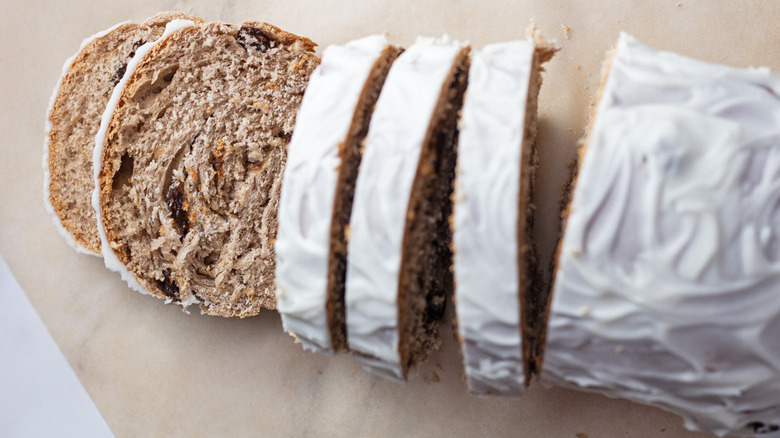
Ingredients
- 4 ½ cups all-purpose flour, divided
- 1 package instant yeast (2 ¼ teaspoons)
- ⅓ cup granulated sugar
- 2 teaspoons salt
- 1 tablespoon ground cinnamon
- 2 cups warm milk
- ¼ cup melted butter, slightly cooled
- 2 cups raisins
- ½ cup confectioners' sugar
- 1 tablespoon heavy cream
- 1 teaspoon vanilla
Directions
- Combine the first 2 cups of flour with yeast, granulated sugar, salt, and ground cinnamon in a large mixing bowl or the bowl of your stand mixer.
- Mix or whisk the dry ingredients together.
- Heat the milk to 105 to 110 F.
- Add the milk and the melted butter to the flour mixture, and combine until you have a smooth liquid batter.
- Add the raisins and 2 ½ cups more flour and mix until a soft dough is formed.
- Knead using your stand mixer for 5 to 6 minutes or by hand for 6 to 8 minutes.
- Transfer the dough into a lightly oiled bowl, cover, and allow to rise for 1 ½ hours or until almost doubled in size.
- Punch the dough down and divide into two portions.
- Transfer first portion to a lightly floured pastry mat or work surface, and roll out into a roughly rectangular shape that is approximately 15x7 inches.
- Roll the dough into a loaf starting on one of the short ends, then pinch to seal the ends.
- Lightly oil or butter 2 9x5-inch loaf pans.
- Transfer the loaf to the prepared loaf pan with the seam side down.
- Repeat the process with the second half of the dough.
- Cover both loaves and allow them to rise for 1 to 1 ½ hours or until they are nearing the edges of your baking pan.
- Preheat oven to 350 F.
- Bake the raisin bread loaves for 35 to 40 minutes or until browned on top.
- Remove the bread loaves from the pans and let cool completely on a wire cooling rack.
- Mix the confectioner's sugar, cream, and vanilla until smooth.
- Ice the top of cooled loaves using a spatula or the back of a spoon.
- Allow the icing to set for 15 to 20 minutes before slicing and serving the raisin bread.
